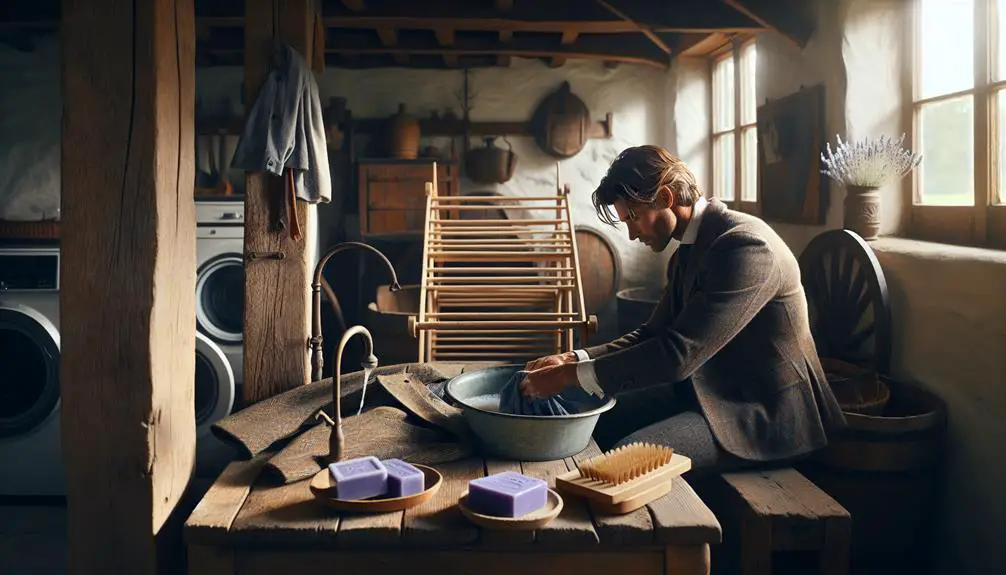So, I've been wrestling with how best to wash tweed without ruining its unique texture and appeal. It's tricky, right? Every time I check the care label, it feels like a gamble between keeping it pristine and actually making it clean. I usually opt for hand washing with a mild detergent, but I've heard some folks throw caution to the wind and use their machines on a gentle cycle. What's your take on this? Have you ever ended up with a tweed disaster, or maybe you've got a foolproof method up your sleeve? I'm all ears for what's worked or flopped for you.
Table of Contents
Key Takeaways
- Check the garment label for specific care instructions before washing.
- Hand wash tweed in cool water using a gentle, pH-neutral detergent.
- Gently swish the fabric in the water; avoid vigorous scrubbing or wringing.
- Lay the garment flat on a towel to dry, away from direct sunlight.
- If machine washing, select a gentle cycle and use a mild liquid detergent.
Understanding Tweed Fabric
Tweed is a durable, woolen fabric known for its distinctive textured feel and intricate patterns. Originally from Scotland and Ireland, this material isn't just about style; its history is deeply intertwined with functionality. Crafted initially to withstand the harsh, damp climates of these regions, tweed's durability is unmatched. It's fascinating how something created out of necessity became so iconic in fashion circles.
The fabric's durability comes from tightly woven wool fibers which not only give it a natural resistance to water and wear but also maintain warmth. Tweed's robustness makes it an ideal choice for outdoor wear. You'll often see it in hunting and hiking apparel, where durability isn't just nice to have, it's essential. This toughness doesn't mean it's stiff or uncomfortable. On the contrary, tweed is surprisingly soft to the touch, a characteristic that makes it suitable for everyday wear as well.
Understanding tweed's origins and durability helps you appreciate why it demands specific care. It's not just another fabric; it's a piece of heritage crafted to last. Knowing this, I approach its maintenance with the respect it deserves, ensuring that its legacy continues through proper handling and care.
Preparing Tweed for Washing
Before washing your tweed, check the garment label for specific care instructions to make sure you're using the right method. This is important as tweed can be delicate, and not all tweed is created equal.
Next up, I always perform a thorough tweed inspection. I look for any spots, tears, or loose threads. This helps me understand the condition of the garment before it hits the water. If there's a small tear, I know to handle it gently or consider getting it repaired first to avoid worsening the damage during the wash.
Color fastness testing is another must-do before washing. You don't want the colors to run and ruin the unique look of your tweed. Here's how I do it: I take a damp white cloth and dab it on a hidden area of the tweed. If any color transfers to the cloth, it's a sign that the fabric might bleed in the wash, which means dry cleaning could be a safer option.
Taking these preparatory steps ensures that I preserve the quality and longevity of my tweed garments. It's all about treating them with the care they deserve to keep them looking their best.
Choosing the Right Detergent
When selecting a detergent for washing tweed, it's important to choose one that's gentle and designed for delicate fabrics. I always look for a detergent that maintains a neutral Detergent pH level, as this is vital to preserving the fabric's integrity and color. Harsh detergents can break down tweed fibers over time, which is definitely something you want to avoid.
Allergy safe options are also a key consideration for me, especially since skin sensitivity can be aggravated by certain chemicals in standard detergents. Opting for a hypoallergenic formula not only protects your skin but also ensures that your tweed garments remain in pristine condition.
Here's a quick table I put together to help you compare some options:
| Detergent Type | Benefits |
|---|---|
| Neutral pH | Protects fabric integrity |
| Hypoallergenic | Safe for sensitive skin, reduces risk of irritation |
| Delicate-specific | Formulated for gentle cleaning |
Choosing the right detergent doesn't just affect the cleanliness of your tweed; it impacts the longevity and appearance of your garments. So, take your time to find a product that fits these criteria and suits your specific needs.
Hand Washing Tweed
I'll now show you how to hand wash your tweed garments safely and effectively. First, fill a basin with cool water and a gentle detergent. Avoid hot water as it can shrink the fabric. Next, immerse your tweed item in the water. It's important to handle it gently to minimize the agitation effects on the delicate fibers.
Don't scrub or twist the fabric; instead, lightly swish it around in the water. This method helps prevent damage while making sure the detergent reaches every part of the garment. After a few minutes, drain the soapy water and refill the basin with clean, cool water for rinsing. Repeat this rinse process until the water runs clear.
For an added touch of care, use a tweed softener in the final rinse. This will keep the fibers soft and maintain the garment's shape and texture. Once rinsed, avoid wringing out the tweed. Lay it flat on a clean towel, roll up the towel, and press gently to remove excess water. Finally, reshape the garment if necessary and lay it flat to dry, away from direct heat or sunlight. This method ensures your tweed remains pristine and durable.
Machine Washing Guidelines
When I switch to machine washing tweed, I've got to pay attention to a few key settings to avoid damaging the fabric.
First, I need to choose the right cycle that's gentle enough to handle the material.
Then, selecting the appropriate detergent and setting the correct temperature and duration is essential for getting my tweed clean without wear and tear.
Selecting Proper Cycle
Selecting the appropriate washing cycle for your tweed garments is essential for preserving their texture and longevity. I always opt for the gentle or delicate cycle on my washing machine, which uses less agitation and can prevent your tweed from becoming misshapen or overly worn.
It's also key to focus on cycle efficiency and water conservation. A shorter, eco-friendly cycle that uses less water and energy while still ensuring your clothes come out clean is a win-win. You don't need a heavy-duty wash for tweed; gentle does the job without the extra wear and tear.
This approach not only keeps your tweed looking great but also contributes to sustainable living by reducing your environmental footprint.
Detergent Type Choices
Selecting the appropriate detergent is essential for effectively cleaning tweed in a washing machine without damaging the fabric. Here's my go-to list for choosing the right detergent:
- Avoid Harsh Chemicals: Steer clear of detergents with bleach or other harsh chemicals. The bleach risks damaging tweed by breaking down its fibers.
- Say No to Fabric Softeners: Don't use fabric softeners. They can coat tweed fibers, reducing their natural texture and breathability.
- Opt for Mild Detergents: Choose mild or wool-specific detergents. These are gentler on tweed and preserve its colors and fibers.
- Liquid Over Powder: Liquid detergents dissolve better and are less likely to leave residues that could mar the tweed's appearance.
Temperature and Duration Settings
To properly wash tweed in a machine, it's important to set the right temperature and washing duration. Tweed's unique texture means you need to be extra careful with water quality and spin speed. Using cold water is best to prevent shrinking and fading. Also, a gentle spin speed is significant to avoid damaging the fibers. Here's a quick guide:
| Setting | Temperature | Duration |
|---|---|---|
| Regular | Cold (30°C) | 30 minutes |
| Delicate | Cold (30°C) | 20 minutes |
| Extra Care | Cold (30°C) | 15 minutes |
Drying Tweed Properly
After washing, lay your tweed flat on a towel to air dry. It's important to handle tweed properly to maintain its shape and texture. Tweed is a resilient fabric, but it does have its quirks when it comes to drying.
Here's a quick guide to make sure your tweed dries perfectly:
- Avoid Fabric Softeners: These can break down tweed fibers over time, reducing the fabric's durability and characteristic texture. Stick to gentle, wool-specific detergents.
- Shade is Your Friend: Never dry tweed under direct sunlight. Sunlight exposure can fade the colors and weaken the fibers. Always opt for a cool, shaded area.
- No Hanging: Hanging tweed can cause it to stretch out of shape. Always lay it flat on a clean, dry towel, flipping it once to ensure both sides dry evenly.
- Patience is Key: Allow the tweed ample time to air dry. Rushing this process with artificial heat sources can lead to shrinkage or damage.
Ironing Tips for Tweed
Now that we've covered how to dry tweed, let's discuss ironing it without causing any damage.
It's essential to set your iron at the right temperature to avoid scorching the fabric.
Also, always use a press cloth to protect the tweed's texture and color.
Proper Ironing Temperature
Setting the appropriate temperature on your iron is essential when pressing tweed to avoid damage. Tweed is a sturdy fabric, but it requires careful handling to maintain its texture and color.
Here's what I always keep in mind:
- Low to Medium Heat: Tweed responds best to a gentle touch. Stick to a low or medium setting to guarantee the fabric's resilience.
- Test First: Always test the temperature on a small, inconspicuous area first to make sure it won't scorch.
- Adjust as Needed: Depending on the thickness, you might need to slightly adjust the heat.
- No Steam: Using steam can affect the fabric's structure and color preservation, so I avoid it unless absolutely necessary.
Using Protective Press Cloth
I always use a protective press cloth when ironing tweed to shield it from direct heat. It's an important step that provides a ton of benefits. The cloth acts as a barrier, preventing scorch marks and shiny spots on your precious tweed garments. Here's a quick table to break down why it's essential:
| Aspect | Benefit |
|---|---|
| Heat Distribution | Guarantees even heat, reducing damage |
| Texture Protection | Prevents changes in tweed texture |
| Moisture Barrier | Keeps direct steam off, limiting wear |
| Shine Prevention | Avoids unsightly shine on fabric |
Storing Tweed Garments
When storing tweed garments, it's important to keep them in a cool, dry place to prevent damage. Moisture and heat can cause your precious tweed to warp or mold, which is the last thing you want after investing in such timeless pieces. I've learned a few tricks to keep my tweed looking fresh and protected all year round.
Here are the key steps I follow:
- Choose the Right Hanger: Always go for padded or wooden hangers to maintain the shape of your tweed garments. Wire hangers can distort the shoulders and fabric over time.
- Cover Up: Use garment bags to shield your tweed from dust. I prefer breathable cotton bags over plastic, as plastic can trap humidity.
- Pest Prevention: To safeguard against moths and other pests without harming the tweed's fragrance, I use natural cedar blocks or lavender sachets instead of chemical mothballs. They keep the pests away and add a nice, subtle scent.
- Avoid Compression: Don't pack your tweed too tightly in the closet. They need air circulation to prevent mustiness and to preserve the fabric's integrity.
Keeping these points in mind has helped me maintain my tweed collection in impeccable condition.
Spot Cleaning Tweed Stains
When I'm dealing with a stain on my tweed jacket, the first thing I do is figure out what caused it. Depending on whether it's a coffee spill or a mud splash, I'll choose a different cleaner to tackle it.
It's all about using the right tool for the job to make sure I don't damage the fabric.
Identify Type of Stain
Before addressing tweed stains, it's crucial to accurately identify the type of stain you're dealing with. Stain analysis starts with a thorough fabric inspection to make sure the correct cleaning method is chosen. Here's how I typically break it down:
- Organic Stains: Includes food, blood, and mud. These usually have a color or texture that aids in identifying them.
- Oil-Based Stains: From greases or cosmetics. They tend to leave a darker spot that's slightly greasy to the touch.
- Water-Based Stains: Such as coffee, tea, or soda. These mightn't always be visible until they begin to set.
- Chemical Stains: From things like ink or dye, which are often more challenging and might affect the dye of the tweed.
This classification guides my next steps in the cleaning process.
Choosing Appropriate Cleaners
Selecting the right cleaner for spot cleaning tweed stains is key to preserving its texture and color. I've found that gentle, non-bleach based cleaners work best. They're less harsh on tweed's delicate fibers. I always do a spot test in a hidden area first to make sure there's no discoloration.
When it comes to stain prevention, handling your tweed with care reduces cleaning frequency and prolongs its life. I avoid eating or drinking while wearing tweed to dodge accidental spills. If a spill happens, I blot—never rub—the stain immediately with a clean cloth. Regularly brushing your tweed also helps in lifting dirt before it settles. Remember, the right maintenance keeps those professional cleanings to a minimum.
Professional Cleaning Options
Exploring professional cleaning options can guarantee your tweed garments maintain their texture and longevity. When I opt for professional cleaning, I'm careful to select services that understand the specific needs of tweed. These experts use the right dry cleaning solvents that are essential yet effective, ensuring that the fabric doesn't lose its distinctive weave and softness. Additionally, professional pressing is important as it helps to preserve the shape and drape of the tweed without causing any damage that might come from ironing at home.
Here's what I typically look for in professional tweed cleaning services:
- Expertise in Wool: I make sure the cleaner has experience specifically with wool and tweed, as their requirements differ importantly from other fabrics.
- Gentle Cleaning Solvents: It's important that the solvents are gentle to prevent damage but effective enough to clean thoroughly.
- Proper Pressing Techniques: The service must offer professional pressing to maintain the garment's structure without risking any heat damage.
- Reputation and Reviews: I always check customer feedback and reviews to gauge the quality of their service and make sure they've a good track record with tweed.
Choosing the right professional cleaner helps me keep my tweed looking impeccable and lasting longer.
Frequently Asked Questions
Can Tweed Be Dyed at Home?
Yes, I've dyed tweed at home before. It's key to choose the right dye and always test for colorfastness on a small area first to make sure the color sets well and evenly.
How Does Weather Affect Tweed Fabric?
Weather really impacts tweed; it's got great insulation but watch out for color fading. I've noticed moisture can dull the vibrant hues, especially if it's left exposed to sunlight too long.
Is Tweed Appropriate for Summer Wear?
I wouldn't recommend tweed for summer; it lacks fabric breathability. While its style versatility appeals across seasons, in heat, you're better off choosing lighter, more breathable fabrics to stay comfortable and cool.
Are There Eco-Friendly Alternatives to Tweed?
Yes, there are eco-friendly alternatives to tweed. I've explored options like recycled polyester and organic wool, both sustainable materials that align with green recycling practices. They're great for reducing environmental impact.
How Do I Repair a Tear in Tweed Fabric?
To repair a tear in tweed, I'd use specific stitch techniques and carefully chosen tear patching materials that match the fabric's texture and color, ensuring the repair is nearly invisible and durable.
- How Does Ring Spun Cotton Affect Garment Fit and Shape Retention? - August 13, 2024
- What Are the Challenges in Producing Ring Spun Cotton? - August 13, 2024
- Is Ring Spun Cotton Suitable for Plus-Size Clothing? - August 13, 2024







